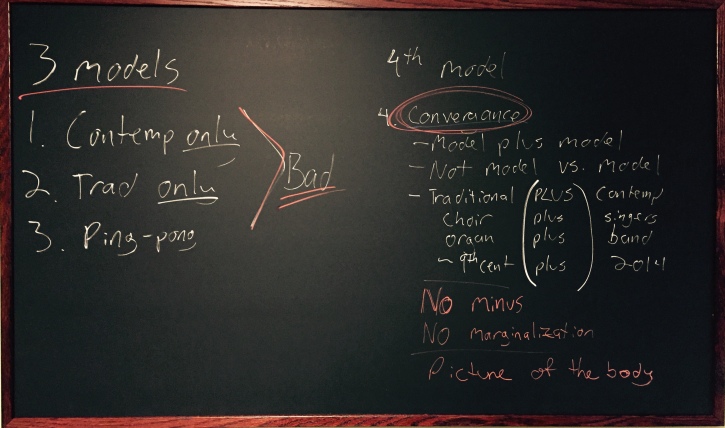
There are three common music models in western/protestant/liturgical churches these days:
1. The traditional model. The music is almost exclusively classical, and any contemporary elements are on the fringes.
2. The contemporary model. The music is almost exclusively modern, and any traditional elements are on the fringes.
3. The ping-pong model. There’s a traditional side and a contemporary side. Each side gets its turn, at its own service, or with its own songs, and there isn’t a whole lot of unity or cooperation.
Is it possible for a church with a history of a traditional music program (choir, organ, hymnals, handbells, etc.) to embrace modern forms of music (bands, vocalists, projected lyrics, “worship teams”, etc.) without the traditional music dying as a result?
Yes, it is possible. And that’s what my church, our congregation, our choir, our instrumentalists, and I are pursuing these days.
We’re pursuing a fourth model, which is called “convergence”. Maybe you call it “blended”. It allows for vibrant traditional music, and vibrant contemporary music, and it puts them together in one combined expression. Choir plus singers. Organ plus band. Traditional plus contemporary. 6th century plus 21st century. Liturgy plus spontaneity. We can play ping-pong when it’s called for, but we play together most of the time.
This “convergence” model accomplishes several things:
1. It’s faithful to our past
2. It builds a bridge to the future, and to those from outside our traditions
3. It’s a picture of the body (independence and interdepence)
4. It’s alive and messy and risky and new and exciting
5. It’s about addition, not about subtraction
Most importantly,
6. It demonstrates our unity in Christ
What does this model mean for a traditional church choir?
This model embraces the choir and calls them further up and further in. Is it different? Yes. Is it the traditional model? No. Is it calling more or less out of the choir than before? More!
In this model of musical “convergence”, being a member of the choir is not just about singing the anthem. It’s about singing and leading all of the songs in a service from beginning to end. From the call to worship to the final hymn. Every note of every song being an opportunity for the choir to fulfill a worship leading role, a congregational-singing-cultivating role, a visible role, an audible role, and a pastoral role. From challenging repertoire, to simple liturgical responses, to contemporary songs that will only (and should only) be in our repertoire for shorter seasons, the choir is being called to be an integral worship leading presence on all of it.
Here’s the kicker about “convergence”:
The addition of new things does not mean the subtraction of older things.
The experimentation with new forms does not mean the elimination of older forms. The birth of new songs does not mean the death of old songs. New singers and musicians on the platform don’t mean the replacement of other singers and musicians. We must force ourselves to think in terms of addition and multiplication, not subtraction and division.
The motto of “convergence” is “More! Older! Newer! All of it!” It’s leaning into what God’s doing, it’s being willing to be messy and make mistakes, and it’s trusting that the foundations are strong enough to handle adding some new structures. This isn’t demolition, it’s expansion. There aren’t any wrecking balls in sight, only more bricks.
And the Cornerstone isn’t going anywhere.
Classical musicians need not run in fear at the sight of an electric guitar. A drummer need not be banished to the youth room, hidden behind plexiglass, and surrounded by foam. Traditional choral repertoire need not be thrown into the trash can. There has to be a way for musical convergence to work. It can work when we love one another, when we keep the congregation singing along, when we exalt Christ above all things and above all preferences, and when we’re willing to take risks in an atmosphere permeated with God’s grace.
Here’s to keeping on trying to make musical convergence work!
 A few months ago at the
A few months ago at the 
 A few years ago I came across a series of CDs called “Prayer Songs”. These are instrumental recordings of Jeff Nelson on piano, and are designed to be played during times of prayer.
A few years ago I came across a series of CDs called “Prayer Songs”. These are instrumental recordings of Jeff Nelson on piano, and are designed to be played during times of prayer. Yesterday I shared some quotes from Harold Best’s book “Music Through the Eyes of Faith”. (
Yesterday I shared some quotes from Harold Best’s book “Music Through the Eyes of Faith”. (